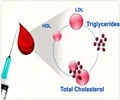The so-called good cholesterol, or HDL is not always a good thing, at least for a certain group of patients, says a new study.

The new study, has for the first time found that a high level of the supposedly good cholesterol places a subgroup of patients at high risk for recurrent coronary events, such as chest pain, heart attack, and death.
The findings could help explain disappointing results from a high-profile Pfizer clinical trial testing torcetrapib, an experimental drug designed to increase levels of HDL cholesterol, that some predicted would become a blockbuster medicine.
The trial was halted in 2006 due to a surprisingly excessive number of cardiovascular events and death.
As in the current study, cardiovascular events in the torcetrapib trial were associated with higher levels of "good" HDL cholesterol, though the reasons were unclear.
"It seems counterintuitive that increasing good cholesterol, which we've always thought of as protective, leads to negative consequences in some people. We've confirmed that high HDL cholesterol is in fact associated with risk in a certain group of patients," said Dr. James Corsetti, professor of Pathology and Laboratory Medicine at the University of Rochester Medical Center and lead author of the study.
Advertisement
"The ability to identify patients who will not benefit from efforts to increase HDL cholesterol is important because they can be excluded from trials testing medications that aim to raise HDL cholesterol. With these patients excluded, researchers may find that raising HDL cholesterol in the remaining population is effective in reducing cardiovascular disease risk," said Dr. Charles Sparks.
Advertisement
Given an inflammatory environment, an individual's unique set of genes helps determine whether HDL cholesterol transforms from a good actor to a bad actor in the heart disease process.
In the high-risk subgroup of patients with elevated HDL cholesterol and CRP, researchers also identified two genetic factors associated with recurrent coronary events.
The activity of cholesterol ester transfer protein (CETP), which moves cholesterol away from the vascular system and is associated with HDL cholesterol, and p22phox, which influences inflammation-related processes and is associated with CRP, are both risk predictors in this subgroup of patients.
"Our research is oriented around the ability to better identify patients at high risk. Identifying these patients and determining what puts them at high risk may be useful in choosing treatments tailored to the specific needs of particular patient subgroups. This gets us another step closer to achieving the goal of personalized medicine," said Corsetti.
The study was published in Arteriosclerosis, Thrombosis, and Vascular Biology, a journal of the American Heart Association.
Source-ANI
SRM














